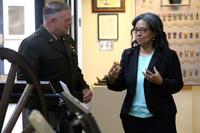SALT LAKE CITY, Utah — Secretary of the Navy Ray Mabus hosted a ship-naming ceremony Jan. 19 to announce SSN 801, a Virginia-class attack submarine, will bear the name USS Utah.
The submarine will be named to honor the history its namesake state has with the Navy.
Utah was home to the Naval Supply Depot Clearfield, which by the end of World War II was the world's largest naval supply. It boasted approximately 16 million total square feet and employed nearly 8,000 civilian employees. It was responsible for buying and selling ship equipment and supplies and for managing the movement of personnel for three West Coast ports that attended to the Pacific Fleet. In addition, the depot distributed automotive and other material for selected activities in three naval districts stretching from North Dakota to Texas.
The future USS Utah will be the second naval vessel to bear the name; the first, a battleship designated BB-31, was commissioned in 1911 and had a long, honorable time in service. The early part of BB-31's career was spent conducting gunnery and torpedo defense exercises.
In 1914, BB-31 became involved in the Mexican Civil War when it assisted in transporting Mexican refugees to Tampico. Following this mission, it was charged with searching for SS Ypiranga, the German ship that was carrying munitions for the Mexican dictator Victoriano Huerta. After this search proved unfruitful, BB-31's battalion spent the next two months fighting in Vera Cruz. Seven men from her battalion earned Medals of Honor as a result of their actions during this time.
Shortly thereafter, BB-31 returned to conducting battle exercises in the Caribbean until the outbreak of World War I. During this time, BB-31 had the opportunity to act as both the flagship for Battleship Division 6, operating out of Ireland, and later, was part of the honor escort for George Washington during its time transporting President Woodrow Wilson to France.
In 1929, it was BB-31's opportunity to have high-ranking officials on her decks when she transported President-elect Herbert Hoover and his official party to Rio de Janeiro.
Two years after this honorable voyage, BB-31 was converted to a mobile target. This allowed it to be controlled by radio gear. It then spent the next nine years training naval aviators in dive, torpedo and high-level bombings. While conducting anti-gunnery exercises in Pearl Harbor, BB-31 was struck by a torpedo and capsized during the initial stages of the Japanese attack. She was struck from the Navy record Nov. 13, 1944 and received a battle star for her service in World War I.
Virginia-class attack submarines provide the Navy with the capabilities required to maintain the nation's undersea supremacy well into the 21st century. They have enhanced stealth, sophisticated surveillance capabilities and special warfare enhancements that will enable them to meet the Navy's multi-mission requirements.
These submarines have the capability to attack targets ashore with highly accurate Tomahawk cruise missiles and conduct covert, long-term surveillance of land areas, littoral waters or other sea-based forces. Other missions include anti-submarine and anti-ship warfare; mine delivery and minefield mapping. They are also designed for special forces delivery and support.
Each Virginia-class submarine is 7,800-tons and 377 feet in length, has a beam of 34 feet, and can operate at more than 25 knots submerged. They are designed with a reactor plant that will not require refueling during the planned life of the ship, reducing lifecycle costs while increasing underway time. The submarine will be built under a unique teaming agreement between General Dynamics Electric Boat (GDEB) and Huntington Ingalls Industries' Newport News Shipbuilding division wherein both companies build certain portions of each submarine and then alternate deliveries. Utah will be delivered by GDEB located in Groton, Connecticut.




























